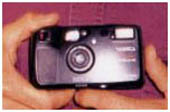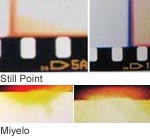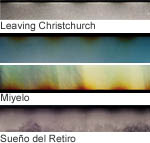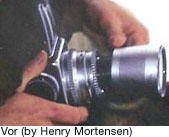|
As a photography apprentice Viggo probably wouldn't pass his exams producing all those pictures full of flaws. Fortunately an artist doesn't have to follow the rules. :-) Viggo isn't the only one photograph using those effects. Under CONNECTIONS
you will find some other interesting photographers. He isn't
tossingh
his camera yet, but he uses other accidents, including broken camera or lens.
* Thanks to Maike Kollenrott
for providing the name!
BLURS
Can have two causes: The object is out of focus, or the camera
or object (or both) are moving while exposing the film Usual
considered as a flaw, the effect can be also used , e.g. to show
movement, or in extremal case like Viggo's, to "paint with
light".
|
 |
FLARES
From Caught
in his own picture by Trine Ross, Politiken, jun 28,
2003"
My camera was broken and when I first saw the developed photos
I got rather cross because I thought they were ruined. But then
I saw that they might have ended up being better. With the next
rolls of film I experimented with controlling the error so I
could place it almost as I wanted to."
From A
Religious Moment Where Something Might Happen: An Interview
with Viggo Mortensen by Scott Thill, 20 September 2002
ST: I was trying to figure out the process for those
flares. I thought that burn came from the development process.
VM: No, it was in the camera. The wiring that advanced the
film and activated the flash got messed up. I was fishing and
dropped the camera and it got wet. When it dried out, it started
doing that. I shot a roll, saw it and thought, "Oh, shit."
But when I looked at them, I thought that some of them looked
kind of interesting. So on the next roll, I tried moving the
wire all the way to one side and the flares would go to that
side. Then I moved it to the middle, the right, and on the bottom
and shot maybe eight rolls of film before it stopped working
altogether.
|
 |
|
According to Farenheit (an article I lost the track of)
the camera was a Yashica 35mm, probably this one:
|
 |
LIGHT BLEEDING
Overexposed areas "bleed" into the black frame of
usually unexposed film. Never seen this before, but I think it
might be caused by wether a light reflection inside of the film
carrier, or some photo-chemical reaction. Seems to be quite common
effect though, as one can see looking at Miyelos or Still Point film stripes
from 45301.
Added on 6. May 04: The first (d)effect I was able to copy using b&w material. (bottom picture)
|
  |
SOLARISATION
Can be seen on some Miyelos.
Extremely overexposured areas of the film can turn into its own
negative. As seen on Miyelo 10 and 12 here, the center of the
sun turns darker.
BTW, Don't mix up this "real" solarisation with
an effect used making prints called solarisation too, although
its real name is Sabbatier effect (involves exposing the partially
developed negative to a controlled dose of light and then continuing
development which produces a part positive/part negative effect
.)
Added on 19.June 2004: Another (d)effect I was able to repeat with the black and white material. The series shows four pictures taken with increasing exposition time (lower shutter speed) until ca. 5 sek. The pictures were developed
shorter than usual to compensate the overexposure (push
developing).
|
  |
SPROCKET SHADOWS
Something I certainly DON'T understand -- rows of stains/darker/different
coloured areas on the edges that seem to match exactly the sprockets
of the film Here is a discussion on something that seems
to be a similar effect.
Theoretically it could be caused by a camera leaking light,
or pulling the film to strong, but Miyelos were taken
with a panoramic Hasselblad XPan, Leaving Christchurch and
Shoe Fence -- with the "flaring"
Yashica in 2000. Sueño der Retiro was made in 2001
so most probably we have three different cameras that unlikely
produce the same effect. What remains is not enough developer
agitation (tried to repeat that but had no luck), or something
that happened while making prints. Again, without knowing if
the used material was negative or dia/slide film and without
seing the cameras (what would I do to get those cameras in my
hands for a little while) it's impossible to say.
|
 |
EXPOSED FILM EDGES
Mostly at the film strip end -- the part one need to put the
film into the camera -- gets exposed also on the edges. 45301
is such case, it seems to be the first picture in the roll. Why
it appears on Long Lead NYC -- it's hard to say.
|
 |
CIRCULAR FRAME
Caused by one of the lenses Viggo uses with his Hasselblad.
Shouldn't be mixed up with a "fisheye" effect caused
by a special lense that distracts the perspective.
(...) "when he puts his Hasselblad camera down it gives
a rolling clonking sound because the end bit of the lens is loose.
Another thing he has taken advantage of photographically".
From Caught in his own picture by
Trine Ross, Politiken, 2003
"We know how he got the tunnel, we know how he got the
circle.... The lens of one of Viggo's camera broke slightly meaning
that the barrel would move without the lens so thus you get the
slightlyblurred edges and colour reflections inside the barrel.
Thank you so much to Lis Steinkce the museum curator for that
piece of information." Hellcat From Farthest Outpost, discussion on Ephemeris,
Jul 01, 2003
It is strange, how the framing influences the photos' mood.
They all seem to concentrate on details, even if there are no
details in the picture, but at the same time the frame build
a distance, they look like a microscope sight, or distant memories...
And now, thanks to Henry and the new book The Horse Is
Good, we can see the famous Hasselblad camera with the famous
broken lens. At least it looks like this...
|
 |
OVERLAYS
Double exposing caused by no (or not completely) advancing
the film in the camera. Instead of being exposed once the area
of the film stores two overlaying images. Wether it is deliberately
done or not -- only Viggo knows...
|
 |
SCRATCHES, MARKS & HOLES
Caused by various metal clips, probably while developing the
film stripes.
|
 |
|










